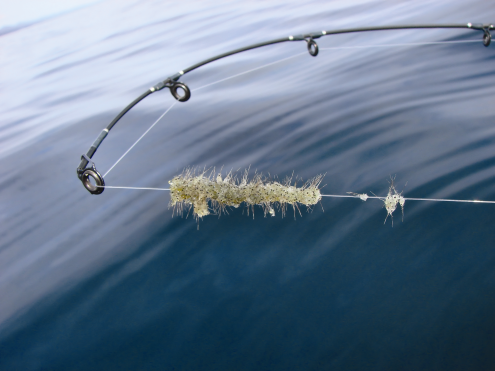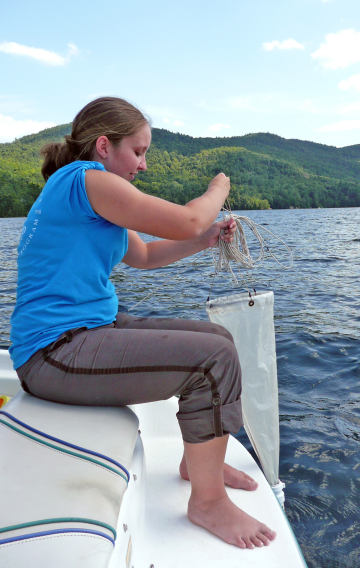
This picture, courtesy of Jeff Gunderson of Minnesota Sea Grant, shows a clump of spiny waterfleas on a fishing line.
Spiny water flea (Bythotrephes longimanus), an aquatic invasive zooplankton native to Eurasia, has been found in Lake George.
The spiny water flea is very small (about ½-inch long). It is not an insect, but is actually a cladoceran, a type of crustacean. While not technically microscopic, it is still very small with about 70% of the length being a thin barbed tail. Many spiny water fleas look like bristly masses of jelly with black eye spots when tangled on fishing lines, reels and other equipment. This species has had negative impacts on Rainbow Smelt and other small fish which are a large forage base for many game fish species. Impacts on fisheries and other aquatic life in the Lake is of concern as this species reproduces rapidly, altering the structure of the in-lake food web. It is of no danger to humans or domestic animals. There is no known current management for spiny water flea. Once it is in a body of water, it is there.
“The most frustrating aspect of this discovery is that we have no recourse that we are aware of now that it is here. You can’t eradicate or even try to manage spiny water flea in a water body as vast as Lake George,” said Walt Lender, the LGA’s executive director.
An angler on his way out of Lake George on Friday, July 27 showed the LGA Lake Steward on duty at the Mossy Point Boat Launch in Ticonderoga a mass of material that had collected on his line when fishing. The Lake Steward collected the sample, and the sample was transported to Larry Eichler at the Darrin Fresh Water Institute in Bolton Landing to confirm the identification. It was confirmed as spiny water flea. On Tuesday, July 31, staff from the Lake George Association used plankton nets to sample in the area where the angler had been fishing; additional spiny water fleas were found in the northern basin just west of Mallory Island. These samples were also confirmed as spiny water flea by Larry Eichler at the Darrin Fresh Water Institute.

To further confirm that an angler had indeed found Spiny water flea in Lake George, the LGA needed to get out on the Lake fast for some additional sampling in the area. LGA members Ken and Jane Robbins, who live in Gull Bay, came to the rescue and took out Kristen Rohne, LGA watershed educator, pictured here.
“It is still too soon to know how widespread the infestation is,” said Emily DeBolt, director of education for the LGA and coordinator of the LGA’s Lake Steward Program. “We went out yesterday to sample to confirm its presence, but we don’t know much more than that it is here. We are working with the Lake George Park Commission, Darrin Fresh Water Institute, and our partners to coordinate additional sampling so that we have more information.”
“Right now the Commission’s top priority is invasive species control and management, and we will work with our many partners on determining the extent of this population,” said Dave Wick, executive director of the Lake George Park Commission. “The Commission is currently developing a comprehensive invasive species prevention plan for Lake George, with the goal of preventing any new invasive occurrences from entering the lake,” he added.
Spiny water flea infested the Great Lakes in the 1980s, but wasn’t found in inland waters of the state until 2008 when it was confirmed in nearby Great Sacandaga Lake. From there it has spread, being confirmed in Peck Lake in 2009, the Stewarts Bridge Reservoir, and Sacandaga Lake in 2010, and the Glens Falls Feeder Canal and Lake Champlain Canal just a few weeks ago in July 2012.
“While this is most definitely not good news, I guess the silver lining is that it is an example of how important education is and that it can work,” said Emily DeBolt. “Some days we feel like a broken record with our spread prevention messages – but this instance shows us that people are listening. It’s encouraging that our messages have reached the population in such a way that an angler recognized that he had something bad on his line and brought it to the attention of one of our Lake Stewards.”
“This is a very disturbing development,” said Lender. “It shows us that we must do more to stop the spread of invasive species. We have no way of telling how spiny water flea came into Lake George and there is little we can do now that it is here, but we should not lessen our efforts to keep invasives out. There are too many on the horizon: species that can do much more to harm our water quality than spiny water flea. This will have a negative effect on our fish population over time, but it will not do the same damage as some of the aquatic plants that have been discovered in other New York lakes such as hydrilla or some of the other animals like quagga mussels or Asian carp.”
